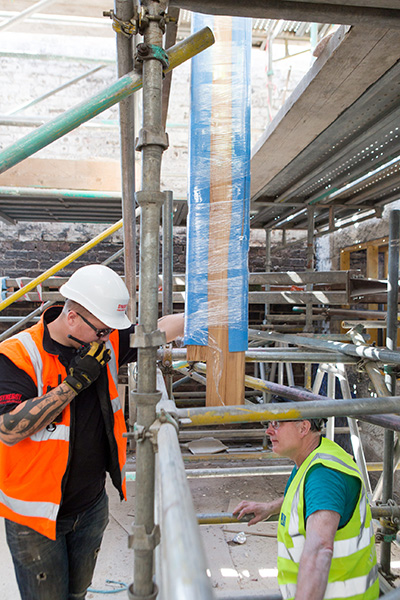
They call it “The Mack”. In 2014, Charles Rennie Mackintosh’s architectural masterpiece in Glasgow, Scotland, was badly damaged in a fire. This past year, we’ve been privileged to provide reclaimed Heart Pine beams for the restoration of the building.
 Charles Rennie Mackintosh was born in Glasgow in 1868. At the age of 15, he began his studies at the Glasgow School of Art. Soon after, he was hired by the architectural firm of John Honeyman and Keppie. He later traveled to England, Italy, and elsewhere in Europe, where he sketched, painted watercolors, exhibited work, and lectured on architecture.
Charles Rennie Mackintosh was born in Glasgow in 1868. At the age of 15, he began his studies at the Glasgow School of Art. Soon after, he was hired by the architectural firm of John Honeyman and Keppie. He later traveled to England, Italy, and elsewhere in Europe, where he sketched, painted watercolors, exhibited work, and lectured on architecture.
At the young age of 28, Mackintosh won a competition to design the new Glasgow School of Art (GSA) building. His design was built in two stages between 1897 and 1910. ‘The Mack’, as it is today called, contains studios, workshops, administration spaces, a library, and a ‘museum’ (the main exhibition space). In a 1901 architectural review of Mackintosh’s design, Lewis F. Day described the building as “planned apparently on lines nakedly utilitarian, yet everywhere revealing the marked individuality of the artist.”
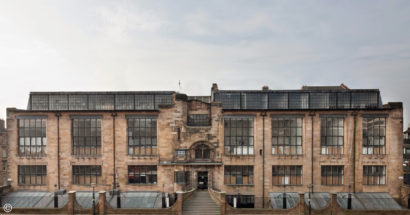
Image courtesy of McAteer Photo
Mackintosh is considered to have bridged several architectural styles and to have been one of the pioneers of the modernist movement. His work clearly reveals his love of nature, his appreciation for Japanese and Art Nouveau design, and a desire to break with the stylistic conventions of his time. Today, the GSA’s Mackintosh Building is considered a building of international architectural significance and one of the most influential buildings ever constructed in Great Britain. Over 20,000 people visit the structure each year.
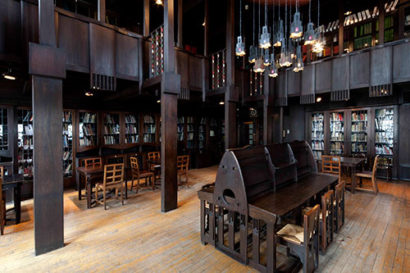
Image courtesy of McAteer Photo
On May 23, 2014, tragedy struck The Mack. A student, working with spray foam, accidentally ignited gases from their pressurized canister. Fire quickly spread through the west wing of the building, utilizing empty ventilation shafts and interior wall corridors to spread from the basement to the roof.
None of the evacuated 200 students or staff were injured and thanks to the efforts of firefighters, almost 90% of the building was saved. But the library, considered one of the world’s finest examples of art nouveau architecture, was destroyed and major damage was done to the roof and west wing. Lost in the library were rare and archival treasures, including light fittings and original furniture. Destroyed at the roof level was the glazed corridor known as the ‘hen run’.
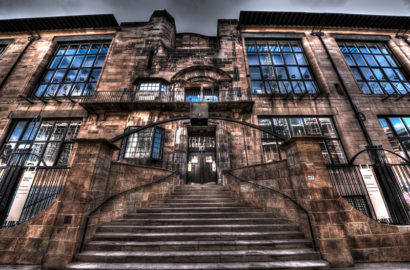
Image courtesy of Lex McKee
After the fire, it was quickly determined that a thorough, exacting restoration would be undertaken. Staff and volunteers from across the country appeared to help physically remove the building’s contents, working as a human chain, moving material to other buildings to dry and be conserved.
As a part of the restoration process, materials such as wood, metal, and brick were sourced to replace those that had existed, and great pains were taken to ensure that they would be faithful to their original counterparts. What can’t be replaced with recycled materials will be replicated. The light fixtures, for example, were painstaking restored: 28 will be made completely from salvaged pieces; seven ‘composite’ lights will be made from a mixture of salvaged items and new pieces; and 18 completely new lights will be made.
One of the studio spaces damaged by the fire was Studio 58. Located above the bookstore, Studio 58 was designed with a pitched roof supported by posts and beams, in a style similar to Japanese timber construction. Four massive southern yellow pine wood tapered columns with rounded edges helped support the roof. The wood was fine-grained and without defects such as shake and fissures.
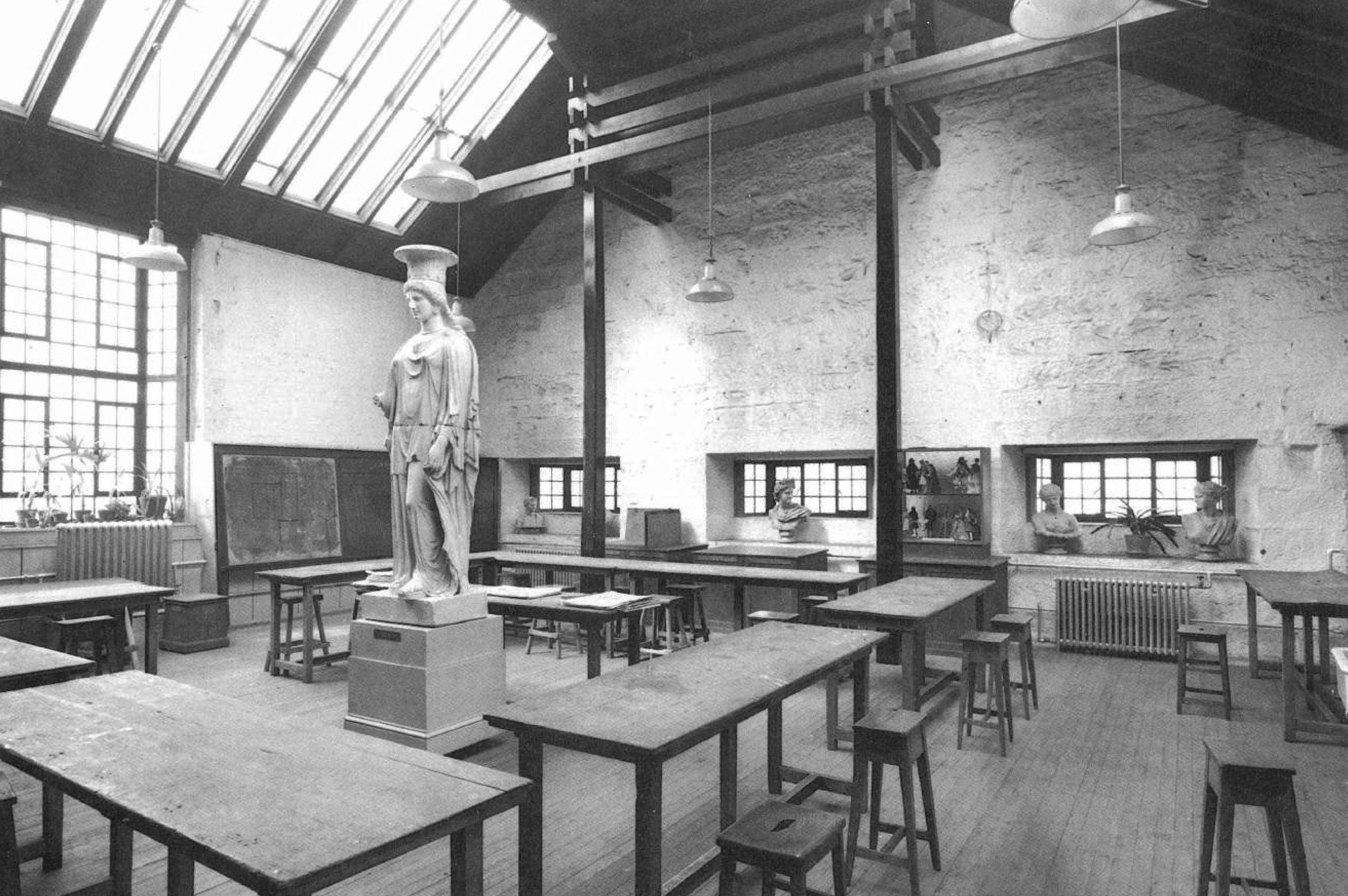
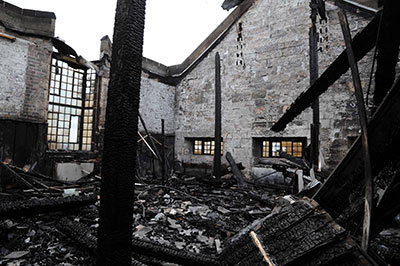
Images courtesy of GSA (Left) and Page\Park Architects (right)
[captionpix img src=”https://www.longleaflumber.com/wp-content/uploads/GSA-archive-women-students-hen-run-1930s-410×521.jpg” captiontext=”Image courtesy of The Glasgow School of Art Archives & Collections” align=”right” alt=”Women Students at the Glasgow School of Art in the Hen Run During the 1930s” width=”165″ height=”210″]Originally used for flower painting, Studio 58 later became the designated women’s studio, and remained so until the 1950s. Although the GSA has always admitted female students, women at the school were in the minority for many years and experienced a different education than male students. Women were originally excluded or segregated from life classes, where training occurred in the drawing of the human form. The destroyed roof-level “hen run” was so named for its physical connection from the women’s Studio 58 to the single women’s lavatory.
When the time came to source the replacement columns in Studio 58, the team in Scotland reached out to Longleaf Lumber. Fortunately, we had just salvaged high-quality southern yellow pine beams from a mill building in Lowell, Massachusetts. The industrial revolution structure had been built in Lowell in 1904 and framed with old-growth heart pine (the type of southern yellow pine used at The Mack). The reclaimed timbers from Lowell were a perfect match for The Mack in Scotland. We selected eight 13-1/2” x 15-1/2″ x 23′ beams and sent them across the Atlantic to Scotland, where they were delivered to the joiners’ workshop in Glasgow to be studied by the team of architects, engineers, and contractors.
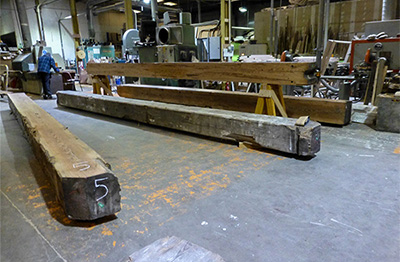
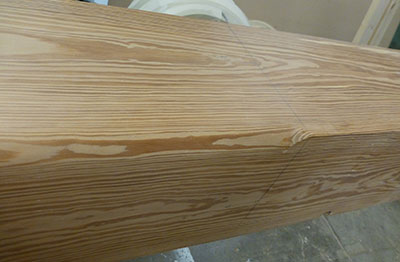
Images courtesy of Page\Park Architects
After closely examining each beam for heartwood content, nail holes, and any other effects of time, the team chose the four that best matched those lost to the fire. For each chosen beam, they determined the end from which they would hand taper the columns, matching the originals. They finished the hand-carving work and lightly sanded with medium-grit sandpaper. Each reclaimed heart pine column tapers both in dimensional size and in the rounding at the arris, bestowing them a graceful profile. After the roof coverings and skylights are complete, the architects plan to apply natural artist oil paint and a beeswax coating to the columns.
On May 26, 2017, the four beams were carefully lowered by crane through the Mackintosh roof into Studio 58. A team was on hand amidst the scaffolding to coordinate with the crane operator and guide each beam into place.

Image courtesy of McAteer Photo / GSA
The restoration of The Mack is a monumental undertaking with multiple players. Kier Construction Scotland was hired as the main contractor. Page/Park Architects are the design team lead. Up to 30 sub-contractors are also involved, including horse hair plasterers and lead glaziers. The project is also tremendous in cost – the price tag is estimated at £35 million (almost $43 million). The current estimated date for completion is February of 2019. The Mackintosh will then be put back into academic use at the heart of the campus.
For more information about the Glasgow School of Art and the Mackintosh Building:
Additional images of the beam installation can be found below. All are courtesy of McAteer Photo / GSA.
Image at page top courtesy of The Glasgow School of Art Archives


